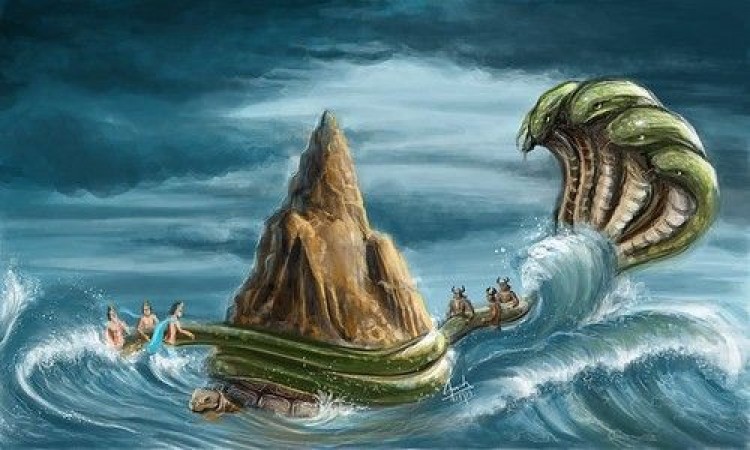
Vasuki, often referred to as Vasuki Naga, is a prominent figure in Hindu mythology, recognized as the king of serpents or nagas. In the rich tapestry of ancient Indian lore, Vasuki holds a significant place, playing various roles in the stories of gods and legendary events. As a divine serpent, Vasuki's presence carries both symbolic and mythological significance. In Hindu mythology, Vasuki is believed to be one of the sons of the sage Kashyapa and his wife Kadru. Kashyapa was a revered sage known for his prolific progeny with various celestial beings and entities. Kadru, the mother of the nagas, is often associated with the serpents or nagas in Hindu mythology. Vasuki is considered the eldest among his serpent siblings.
One of the most famous episodes involving Vasuki is the churning of the ocean, known as Samudra Manthan. In this mythological event, the Devas (celestial beings) and Asuras (demons) came together to churn the cosmic ocean to obtain the nectar of immortality (amrita). To facilitate the churning process, they used Mount Mandara as the churning rod and Vasuki as the rope. Vasuki, with his immense strength, coiled himself around Mount Mandara and acted as the rope with one end held by the Devas and the other by the Asuras. As the churning commenced, various celestial beings, precious gems, divine medicines, and other treasures emerged from the ocean. The role of Vasuki in the churning of the ocean symbolizes his crucial role in supporting the cosmic order and participating in the divine events that shape the universe. Vasuki has strong associations with Lord Shiva, one of the principal deities in Hinduism. According to some legends, Vasuki is depicted as wearing the snake around his neck, symbolizing the serpent's devotion and surrender to Lord Shiva. The snake's adornment around Lord Shiva's neck has earned him the title "Nagendra" or "Lord of Serpents." Moreover, Vasuki is believed to have played a significant role in the episode of the "Samudra Manthan," where he offered his cooperation to the Devas and Asuras in the churning of the ocean, reflecting the harmonious relationship between the divine and the serpents in Hindu mythology.
Apart from the Samudra Manthan, Vasuki is mentioned in various other mythological stories, often depicted as a wise and powerful serpent king. His interactions with other deities and sages in these tales showcase his diverse roles in the cosmic drama of Hindu mythology. Vasuki's symbolism goes beyond his physical presence in mythological narratives. The serpent is a potent and recurring symbol in many ancient cultures, often representing fertility, transformation, and hidden knowledge. In Hindu spirituality, snakes are regarded as having both protective and destructive aspects, representing the dual nature of creation and the cycle of life and death.
In conclusion, Vasuki, the serpent king of Hindu mythology, holds a significant place in the ancient lore and symbolism of India. His association with Lord Shiva, participation in the churning of the ocean, and his portrayal as a wise and powerful serpent king underscore his importance in the cosmological order. Vasuki's symbolism extends beyond mythological narratives, inviting philosophical contemplation and reflecting the eternal dance of creation and destruction in the vast tapestry of Hindu spirituality.
Also read -Kailash Mansarovar: A Historic, Cultural, and Religious Gem Lost in Indo-China War